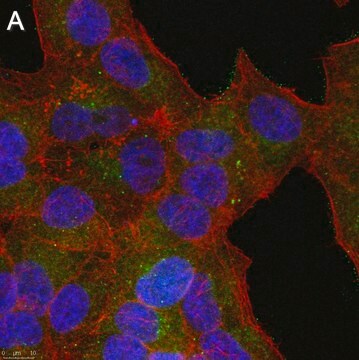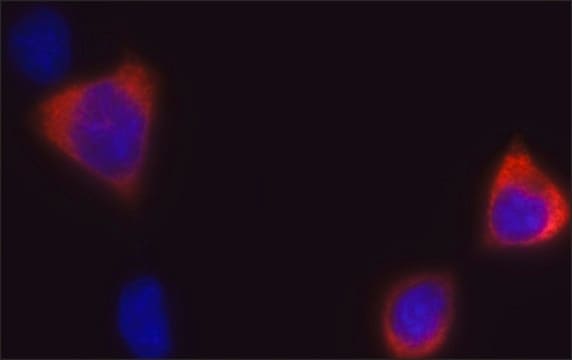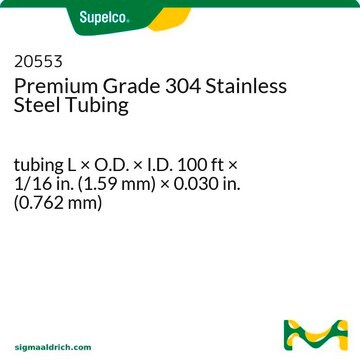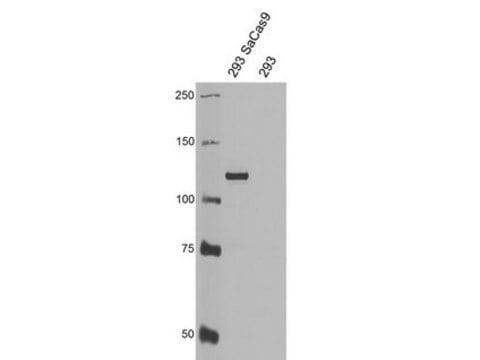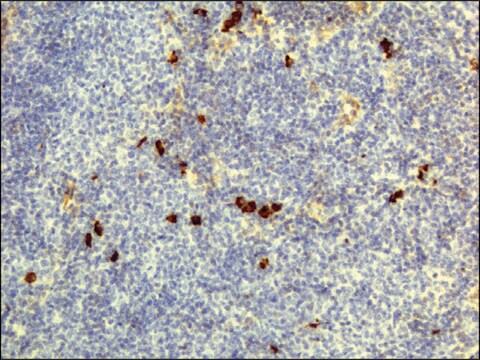SAB4200777
Anti-LbCas12a (Cpf1) antibody, Mouse monoclonal
clone LbCpf1, purified from hybridoma cell culture
Sinonimo/i:
Anti-CRISPR-associated endonuclease AsCas12a from Lachnospiraceae bacterium ND2006, Anti-LbCpf1 antibody, Mouse monoclonal
Scegli un formato
About This Item
Prodotti consigliati
Origine biologica
mouse
Livello qualitativo
Forma dell’anticorpo
purified from hybridoma cell culture
Tipo di anticorpo
primary antibodies
Clone
LbCpf1, monoclonal
Stato
buffered aqueous solution
PM
~135 kDa
Concentrazione
~1.0 mg/mL
tecniche
immunoblotting: 0.6-1.2 μg/mL using human HEK-293T cells over-expressing LbCpf1 protein
immunofluorescence: 0.25-0.5 μg/mL using human HEK-293T cells over-expressing LbCpf1 protein
immunoprecipitation (IP): 1-2.5 μg/test using lysate of human HEK-293T cells over-expressing LbCpf1 protein
Isotipo
IgG1
N° accesso UniProt
Condizioni di spedizione
dry ice
Temperatura di conservazione
−20°C
modifica post-traduzionali bersaglio
unmodified
Descrizione generale
Cpf1 (CRISPR from Prevotella and Francisella 1) belongs to class 2 type V CRISPR-Cas endonuclease system. Cpf1 comprise several differences from Cas9 protein including cleavage with 5′ overhangs, a shorter guide RNA and a longer distance between the seed sequence and cleavage site.
LbCpf1, Cpf1 from Lachnospiraceae bacterium ND2006, was examined together with 15 members of Cpf1 nuclease family and proved to mediate efficient genome editing in HEK293FT cells with improved results compared to SpCas9.5 According to thr crystal structure, LbCpf1 has a triangle-shaped architecture with a large positively charged channel at the centre.7 The crRNA binding was shown to induce the pronounced structural rearrangements of LbCpf1, leading to formation of a substrate-binding conformation of LbCpf1. Over-expressed in plant cells, LbCpf1 demonstrated more than 10-fold transcriptional repression of the target gene.
Monoclonal anti-LbCpf1 antibody can provide a useful tool for genome editing research, such as detecting and monitoring LbCpf1 positively transfected cells.
Immunogeno
Applicazioni
Stato fisico
Stoccaggio e stabilità
Altre note
In order to obtain best results in different techniques and preparations we recommend determining optimal working concentration by titration test.
Non trovi il prodotto giusto?
Prova il nostro Motore di ricerca dei prodotti.
Codice della classe di stoccaggio
12 - Non Combustible Liquids
Classe di pericolosità dell'acqua (WGK)
nwg
Punto d’infiammabilità (°F)
Not applicable
Punto d’infiammabilità (°C)
Not applicable
Scegli una delle versioni più recenti:
Certificati d'analisi (COA)
Non trovi la versione di tuo interesse?
Se hai bisogno di una versione specifica, puoi cercare il certificato tramite il numero di lotto.
Possiedi già questo prodotto?
I documenti relativi ai prodotti acquistati recentemente sono disponibili nell’Archivio dei documenti.
Active Filters
Il team dei nostri ricercatori vanta grande esperienza in tutte le aree della ricerca quali Life Science, scienza dei materiali, sintesi chimica, cromatografia, discipline analitiche, ecc..
Contatta l'Assistenza Tecnica.



